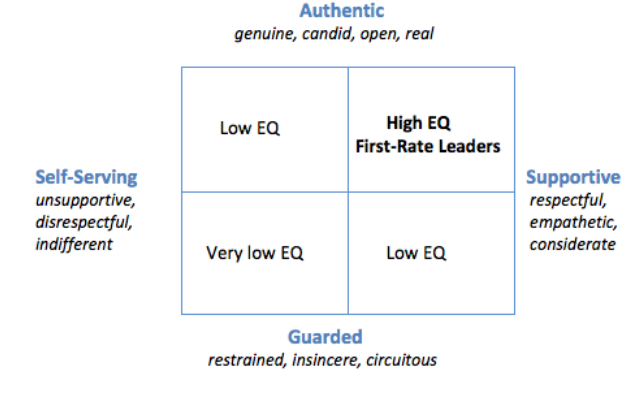What Makes First–Rate Leaders, First–Rate?
We’ll quickly answer this question—and then we’ll move to the really important bit…
What can you immediately do to close the gap between
where you sit now and where a first–rate leader sits?
What The Research Is Telling Us
Talentsmart’s recent research backed up more than two decades of studies when it concluded, “90% of top performers have high emotional intelligence (EQ)”.
I’ve condensed the research about top performing leaders in this way…
First-rate leaders show high EQ by:
- Inspiring—they’re motivational
- Influencing—they’re persuasive
- Communicating—particularly acknowledging that they’ve heard
- Connecting with others—connecting through both the head and the heart
- Cultivating their team members—they coach them or have them coached
- Understanding their own thoughts and feelings—they invest time and energy in developing this self-awareness
- Empathising—with others’ wants, needs, fears and concerns.
OK, let’s look at how we can make that list more useful—aka, easy to apply…
“The difference between a novice and an expert is that the expert has a schema (a model) to work to.”
Read on, you’re about to become an expert…
Template Of First–Rate Leaders’ Behaviours
If you’ve spent much time with me you’ll know how much I like a 2 x 2 matrix. Continuums and categories help explain most things. And make them easier to understand—well, perhaps not the inexplicable Brexit.
Here’s my ready to implement template that you’re welcome to call your own :-).
Be aware that the horizontal line and the vertical line is a continuum.
Your task is to ask yourself where you sit on both continuums, a) when circumstances are normal, and b) when you’re experiencing stress.
Your answers to those questions will determine which quadrant you tend to spend most of your time in when things are normal and when you’re stressed:
Think about a first-rate leader you know—they’re authentic and supportive, aren’t they?
Now think about someone who’s got a way to go before they’re first-rate—They’ll be closer to the self-serving and guarded ends of the continuum.
Your Action Steps
Think back to conversations you’ve had in the last few days…
Where were you close to first-rate on the matrix—and where could you have been more authentic and more supportive?
I urge you to keep the matrix front-of-mind (such as, in the book you carry from meeting to meeting. Or on your computer desktop. Or even stuck on your wall).
Keep checking where your leadership behaviours sit on the Authentic—Guarded continuum and on the Self-Serving—Supportive continuums.
Watch. Miraculously, you’ll move closer to being first-rate!
“Since working with Carolyn, perceptions of me have improved a lot…
I realise that I don’t need to work long hours to do a good job.
Now I have time to think ahead, and to think strategically.”
—Leader, business process outsourcing company
ABOUT THE AUTHOR:
Carolyn Stevens has worked with leaders for more than 25-years—hundreds of them.
She’s supported leader after leader (including those who previously struggled to confront the difficult, let alone persuasively deal with the it) flourish—and become confident, courageous and impressively influential.
Carolyn is authentic and results-oriented. She draws on an eclectic array of approaches, tools and techniques to suit the situation.



